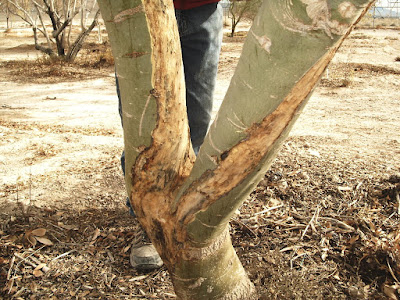This was an exchange regarding a tomato problem. The first exchange..Q1... I did not have pictures to go on. The second exchange Q2....I was sent pictures. Pictures help alot!! Still not sure what it is exactly and only a plant pathologist would know for sure but sanitation recommendations and buying transplants from a good grower are still good suggestions....Xtremehort
Q1. Most of my 12 tomato plants have developed. A light brown appearance on their leaves. It looks kind of like they have dirt on them. The fruit all looks normal. Any suggestions?
Otherwise, pull these plants out and get them out of the garden area.
Sanitize all your tools. Cleanup all debris in the garden. Replant with tomato
seedlings in mid July to August 1. Or start some tomato plants directly from
seed yourself in mid-July for a fall crop. Tomatoes will start setting fruit
again when temperatures drop below 95 ° F consistently.
Q1. Most of my 12 tomato plants have developed. A light brown appearance on their leaves. It looks kind of like they have dirt on them. The fruit all looks normal. Any suggestions?
A1. It is difficult to
identify a problem without seeing it unless something just jumps out at you. In
this case it doesn't. But let me tell you how I would approach it. From your
description, I don't think it's a disease problem. It could possibly be an
insect or spider might problem. re{ you mention dust
I would spray the leaves
with a soapy water solution. Insecticidal soaps are my first choice. My second
choice is to make your own using a liquid Castile soap and water at a rate of
about 1 tablespoon per gallon. Spray both the tops of the leaves as well is the
bottom of the leaves. Soaps are very lethal to insects. They kill good ones and
bad ones equally and don't discriminate.
In your case I don't think
these are good insects. I am leaning towards spider mites if it has been hot
and dry lately Or if you sprayed an insecticide on them lately. Make sure that
you feed tomato plants once a month lightly with a fertilizer. Either apply it
to the soil or sprayed on the leaves during early morning or early evening
hours.
Q2. Mine is a backyard
garden with limited space. I grow six
plants in the ground and 4 more in big pots. I add a couple cubic feet of
garden soil every year. Don't have many options. I suspected the issue came
from the nursery. They are into quantity rather than quality. So, is there
anything I can do at this point to treat the plants?
Here are two pictures, one
taken in the sun and the other in the shade. Thanks for your response.
A2. Thanks for the
pictures. It helped. Notice how the brown spots are closely associated with the
leaf veins. That is important and indicates to me a tomato disease problem. It
is difficult to tell from pictures but I am leaning towards bacterial canker.
It is not one of the more common tomato diseases that we see in vegetable beds
like early blight. I believe this disease came with the transplants when you
bought them. If you grew your own transplants, then the seed was contaminated
or the beds where they are grown were not thoroughly clean when you planted.
Another possibility is
that tomatoes were grown in that location in previous years. When you continue
to grow the same vegetables in the same areas year after year, diseases tend to
build up in the soil and it's difficult to grow plants in that location Of the
same family. This is why it is important to rotate vegetables into new
locations every year. Do not grow anything in the tomato family in that spot
for the next 3 to 5 years. You can grow vegetables in different families there
such as the cucumber family, onion family, carrots, beets but not tomatoes,
peppers, eggplant or potatoes. They are all in the tomato family.
If the tomato plants are
still alive, I would cut them back and remove about one third to half of the
entire canopy of the plants. Don't give them a butch haircut but try to remove
one entire stem where two come together. You want to open the canopy of the
plant for air movement but you don't want to open it too much and cause
sunburn. It will be a little tricky. Once you do that, lightly fertilize them
and deep water them. If you prune them correctly, you should start to see new
growth coming lower on the stems. Protect this new growth.
Diseases can be moved
around on tools, your hands, clothing so make sure that everything is sanitized
with 70% ethyl alcohol. Be sure that no debris, no rotting fruit, no plant
parts, no weeds are present in the area.





























